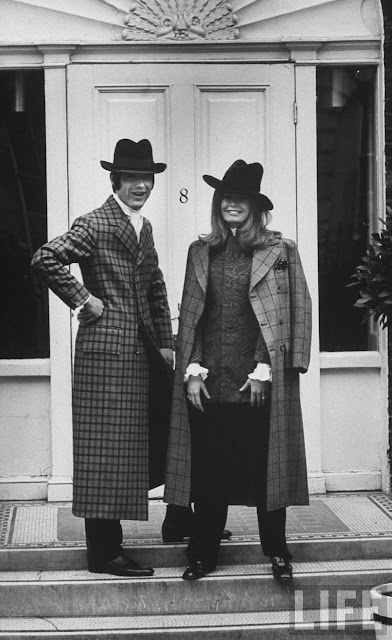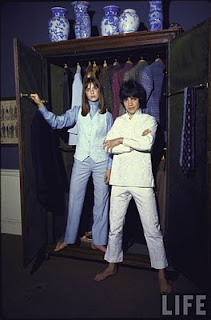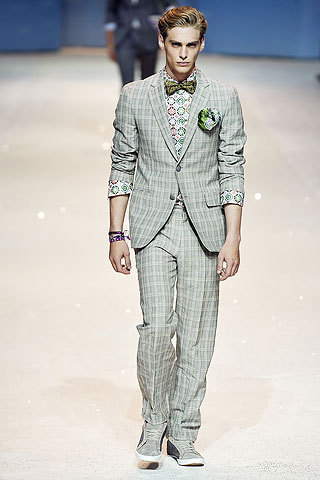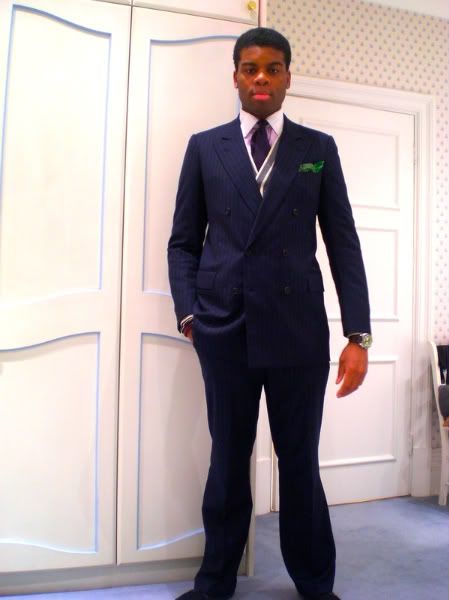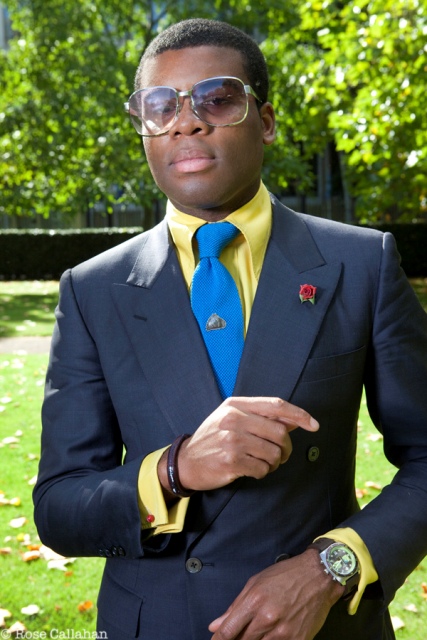Now, Bunny is not memorialised for nothing – in life and death, his sartorial renown and his predilections spread deep and wide. Fine and exacting tailoring performed by long-defunct Savile Row house Watson, Fargerstrom & Hughes; the sexual companionship of other men; heavy powdering; carnations; couture design; punctiliousness; the organisation of greatly hedonic parties; bon mots; bon vivantism; fine art and antiques; Rolls Royces; colour complementing, and so forth
This champagne socialite is remembered as one of the most interesting characters from the 1940s right through to his existence failure in 1997. In the internet age, he is lionised or minimised, depending on which side of the divide created by the awareness of a refined homosexual with a fondness for lurid Lurex ensembles and drag that one falls
Lurex printed Nehru and casual purple wool sportcoat from the 1970s with Turnbull & Asser shirts and sporrans, from the catalogue of Sotheby's 1998 auction of Bunny Roger's estate
As a relatively nascent fan of extravagant libertines, Roger’s dedication to his aureate lifestyle is, to me, practically peerless. His cordwainers, Poulsen, Skone & Co., created four pairs of dress shoes and boots for his 150-strong collection of tailored suits. Each. I can imagine that he had at least three outings with every individual pair. Most enviable is that he actually had the space to accommodate 600 shoes, to say nothing of seasonal and occasional footwear such as espadrilles, slippers and evening footwear
(I’ll bet he was a pump man)
Also of interest is the Neo-Edwardian milieu that he exemplified (
and that I've dabbled in). To most people, the term, although self-explanatory, probably doesn’t mean much until one mentions the much parodied City of London look and the performances of John Cleese and Patrick MacNee in
Monty Python’s 'Ministry of Silly Walks' sketch and
The Avengers, respectively. As I understand it, the label, “Edwardian,” itself puts some tailoring enthusiasts in mind of this look
The middle image, 'Savile Row/The New Mayfair Edwardians' (Peter Coats; William Ackroyd; Mark Gilbey), was shot by Norman Parkinson in 1950; Parkinson was also the lensman behind a portrait of Roger stood near his ornately printed car in 1954
As noted in the opening photograph of Roger, Neo-Edwadianism in dress, as well as deportment, was a nostalgic exhumation and customisation of an old style. It was the ideal postwar reaction; emerging from half a decade of atrocity, loss and devastation and seeking reinvigoration in the aftermath, Row tailors advocated this fashion to entice customers back to suiting
Of course, with the likes of Bunny Roger as a paragon, the movement eventually came to be somewhat associated with the surreptitious and the naughty
Having viewed a number of Neo-Edwardian looks of late, I’ve noted a pleasing variation of styling, although the defining elements are clear. A bowler hatted silhouette encompassed a fitted look, with its long and lean jacket – slightly flared at the skirt – and slim, straight trousers. Pearl pins were often affixed to the ties. An umbrella, as it came to succeed canes, became obligatory. Turn ups were seemingly rare – Bunny, for one, rigorously disapproved of them. As the aesthetic's most well known paradigm, his waist (29 – 31”) and broad upper build (40”, same as I) gave him the sharpest profile of all
The disparities were where things became more interesting. As the 1950s became the 1960s, the relative sobriety of the look grew suffused with wild abandon in the encroaching age of modernity and Modernism. Interwar austerity was over
By the 1960s, it had integrated eight buttoned double breasteds, four buttoned single breasteds, turnback cuffed dress suits, brass buttons and a myriad of showy fabrics. The dependably ostentatious Bunny commissioned his most outré suiting designs during that time; his peccadilloes of dress had already won him the respect and following of the Teddy Boys, who were the less elite and refined, and more ragtag and youthful exponents of this Edwardian reminiscence
They tend to be better remembered, perhaps due to being young and shifty
On the right, Hamish Bowles, photographed at his New York abode for Fantastic Man, wears one of Roger's WF&H checked suits, one of a number he acquired at the posthumous Sotheby's auction of Roger and his brother Sandy's effects. Apparently, the somewhat elfin Bowles has to breathe in to accommodate the seamwork designed for Roger's waisted physique
Hardy Amies had also picked up on Roger’s trendsetting. Whilst he summarised the general Neo-Edwardian/London aesthetic of the 1950s as “
the average young man of position [trying] to give an air of substance without being stodgy: of having time for the niceties of life” and “
uncomfortable in anything other than a hard collar and a bowler hat,” he believed Bunny’s particular cut and quirks would usher in the defining styles of the 1960s. No surprise that Roger was one of his investors, but then Amies knew tasteful change - the mark of a talented dresser - when he saw it:
Hardy Amies Four Buttoned Suit, circa the 1960s
Then the Edwardian look grew into something else entirely:
While its name reflected its homage to turn-of-the-century men’s fashions, the trend was equally influenced by the nineteenth century dandy and his flare for the dramatic. The result was a highly theatrical style of dress in which no self-respecting Edwardian (emphasis: mine) gentlemen would have been caught dead, least of all after six o’clock
The aesthetic evolved well into the early 1970s, intersecting with the neo-Regency remixes of the Peacock Revolution, before the energetic, neo-1930s exaggerations of the 1970s claimed a sturdier hold on the tailoring world (one school of thought suggests that the 1960s did not truly end until 1972)
Bunny, however, continued on his idiosyncratic way. The most famed imagery from his late period comes from his birthday shindig in 1981:
At the Amethyst Ball in London's Holland Park, held to celebrate his 70th birthday, 9th June 1981 (photograph by Terence Donovan Archive/Getty Images). Naturally, anyone not in a lilac hued outfit was unceremoniously rejected
Despite his visibility in all matters sartorial, he remained more quasi-iconic in stature. Luckily, we live in an age that can deliver information on him at the click of a keystroke
After all's said and done, I can't help but find common ground with a man who loved offbeat formality and
the colour purple
And above all, Bunny Roger was a true gentleman
Cigars to StyleForvm, Sator and Carpu at The Cutter and Tailor, and The Neo-Edwardian Hipster



































